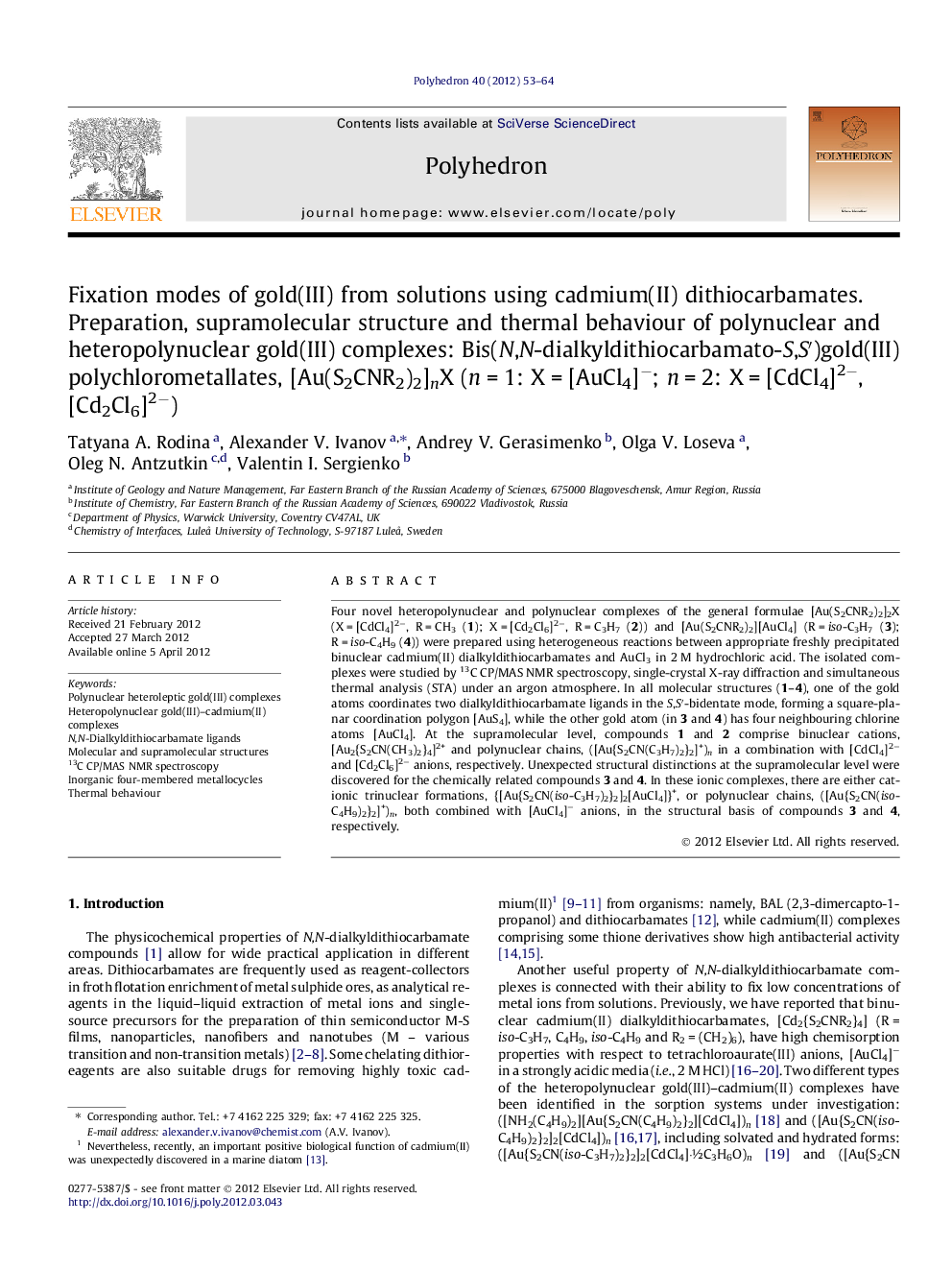| کد مقاله | کد نشریه | سال انتشار | مقاله انگلیسی | نسخه تمام متن |
|---|---|---|---|---|
| 1337478 | 1500290 | 2012 | 12 صفحه PDF | دانلود رایگان |

Four novel heteropolynuclear and polynuclear complexes of the general formulae [Au(S2CNR2)2]2X (X = [CdCl4]2−, R = CH3 (1); X = [Cd2Cl6]2−, R = C3H7 (2)) and [Au(S2CNR2)2][AuCl4] (R = iso-C3H7 (3); R = iso-C4H9 (4)) were prepared using heterogeneous reactions between appropriate freshly precipitated binuclear cadmium(II) dialkyldithiocarbamates and AuCl3 in 2 M hydrochloric acid. The isolated complexes were studied by 13C CP/MAS NMR spectroscopy, single-crystal X-ray diffraction and simultaneous thermal analysis (STA) under an argon atmosphere. In all molecular structures (1–4), one of the gold atoms coordinates two dialkyldithiocarbamate ligands in the S,S′-bidentate mode, forming a square-planar coordination polygon [AuS4], while the other gold atom (in 3 and 4) has four neighbouring chlorine atoms [AuCl4]. At the supramolecular level, compounds 1 and 2 comprise binuclear cations, [Au2{S2CN(CH3)2}4]2+ and polynuclear chains, ([Au{S2CN(C3H7)2}2]+)n in a combination with [CdCl4]2− and [Cd2Cl6]2− anions, respectively. Unexpected structural distinctions at the supramolecular level were discovered for the chemically related compounds 3 and 4. In these ionic complexes, there are either cationic trinuclear formations, {[Au{S2CN(iso-C3H7)2}2]2[AuCl4]}+, or polynuclear chains, ([Au{S2CN(iso-C4H9)2}2]+)n, both combined with [AuCl4]− anions, in the structural basis of compounds 3 and 4, respectively.
We report on a chemisorption activity of four cadmium(II) dialkyldithiocarbamates, [Cd(S2CNR2)2]n R = CH3, C3H7, iso-C3H7 and iso-C4H9, with respect to [AuCl4]− ions in 2 M hydrochloric acid. Polynuclear heteroleptic complexes, bis(N,N-dialkyldithiocarmato-S,S′)gold(III) polychlorometallates: [Au(S2CNR2)2]nX (n = 1: X = [AuCl4]−, R = iso-C3H7 (3), iso-C4H9 (4); n = 2: X = [CdCl4]2−, R = CH3 (1); X = [Cd2Cl6]2−, R = C3H7 (2)) were isolated as the fixation modes of gold(III) and studied using 13C CP/MAS NMR spectroscopy, single-crystal X-ray diffraction and simultaneous thermal analysis (STA). In the cations, the gold atoms S,S′-bidentately coordinate two dialkyldithiocarbamate ligands forming the coordination polygons [AuS4], while in the anions, the central atoms are characterised by the neighbouring environment of four chlorine atoms [MCl4] (M = Cd, Au). The square-planar geometry of both types of Au(III) chromophores reflects a low-spin, intraorbital dsp2 hybrid state of the gold atoms. Unusually complicated supramolecular structural organisations were found for all isolated complexes: (i) binuclear cations, [Au2{S2CN(CH3)2}4]2+, (ii) trinuclear formations, {[Au{S2CN(iso-C3H7)2}2]2[AuCl4]}+, and (iii) polynuclear chains, ([Au(S2CNR2)2]+)n, (R = C3H7 and iso-C4H9), all in combination with (iv) [AuCl4]−, (v) [CdCl4]2− and (vi) [Cd2Cl6]2− ions, are in the structural basis of compounds 1–4. TG and DSC techniques were employed to study thermal behaviour of complexes 1–4 under an argon atmosphere.Figure optionsDownload as PowerPoint slideHighlights
► Polynuclear gold(III) and gold(III)–cadmium complexes comprising dithiocarbamate ligands.
► Supramolecular self-organisation of [Au(S2CNR2)2]nX (n = 1, X = [AuCl4]−; n = 2, X = [CdCl4]2− and [Cd2Cl6]2−).
► Four-membered chelate rings [AuS2C] and the planar [AuS4] and [AuCl4] chromophores.
► Thermal decomposition of the complexes yields reduced metallic gold as the final product.
Journal: Polyhedron - Volume 40, Issue 1, 19 June 2012, Pages 53–64